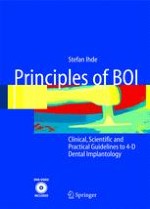Gepubliceerd in:
2005 | OriginalPaper | Hoofdstuk
9. Four-Dimensional Considerations of Bone Morphology and Mechanics
Abstract
In this chapter, we shall explain bone properties based on a number of concepts, each illuminating one specific aspect of the osseous life cycle. All of these concepts are applicable at the same time, and they are indeed relevant for our implantological work.
